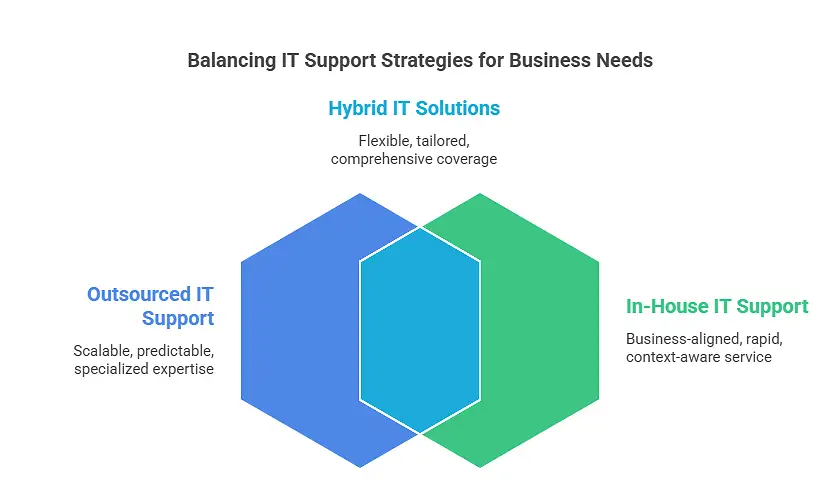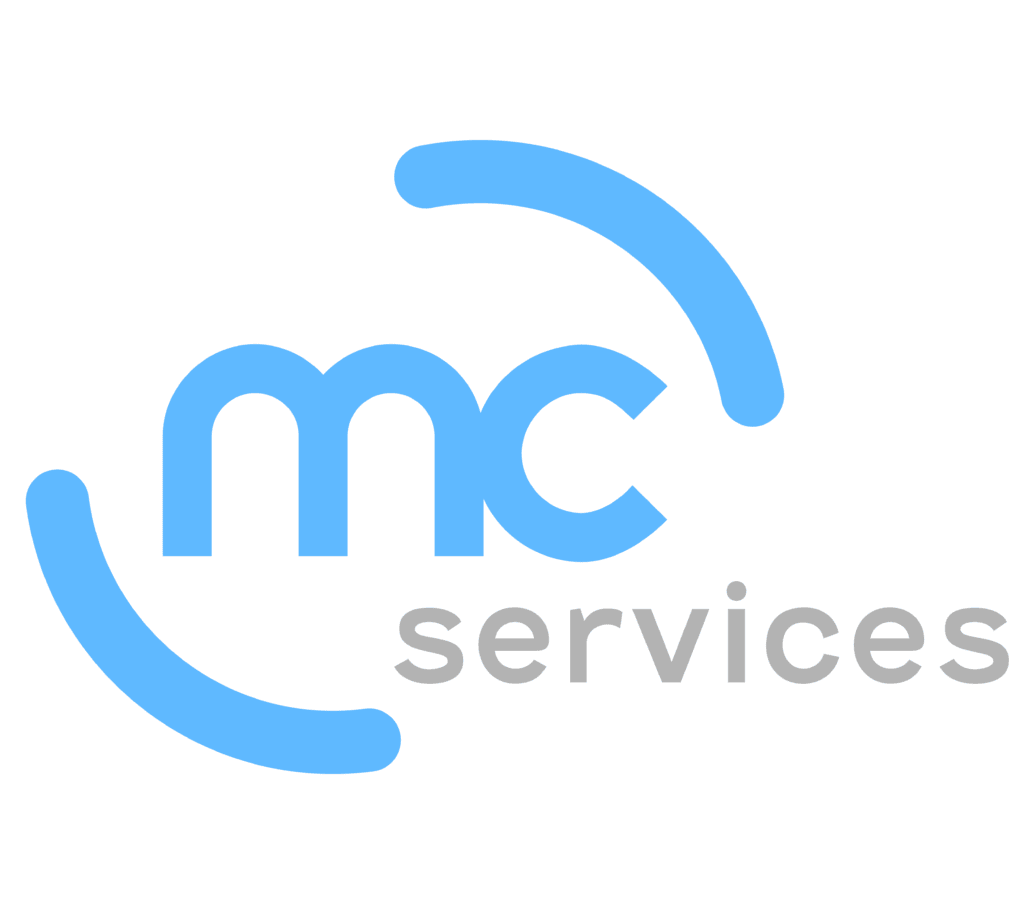Milwaukee IT Support Provider Breaks Down Helpdesk and IT Support
Many businesses mistakenly treat helpdesk and IT support as interchangeable roles. But the distinction matters because it directly impacts uptime, operating costs, and team productivity.
According to Atlassian, unplanned downtime costs small businesses an average of $427 per minute. For IT leaders, blurring the lines between ticket intake and deep technical work can lead to costly delays and resource waste.
| “Clear role definitions in IT support functions prevent bottlenecks and wasted resources.” – Duane Maas, Director at MC Services |
In this blog from a reliable IT support provider in Milwaukee, you’ll learn how to:
- Distinguish helpdesk from IT support
- Know when to scale each function
- Design smooth handoffs that reduce friction
- Build SLAs that protect performance
By the end, you’ll have practical strategies to improve uptime, reduce ticket delays, and make smarter IT staffing decisions.
What Helpdesk and IT Support Teams Do
Helpdesk and IT support are two distinct but closely connected functions. Together, they ensure systems stay operational and users remain productive. Understanding their roles helps you to assign tasks efficiently and avoid overlap.
IT Helpdesk: The Frontline of User Support
The help desk acts as the first point of contact for users. It handles routine issues that don’t require deep technical expertise. For example, password resets or basic software help.
When helpdesk resolves common problems quickly, they free up IT support to focus on more complex challenges.
Helpdesk’s core duties are:
- Ticket intake and triage: Handles common issues such as login problems or app glitches. Verifies user identity and assesses, resolves, or escalates urgency.
- User guidance and ticket routing: Provides clear next steps and sets expectations. Ensures tickets are tracked and routed to the right team.
- Knowledge base management: Creates and updates FAQs and help articles. Reduces repeat questions and speeds up onboarding for new users.
IT Support: The Backbone of Technical Stability
IT support does the deeper technical work that secures and optimizes your IT infrastructure. They manage servers, networks, backups, and system integrations. Their focus is on solving root causes, not just symptoms, to prevent recurring issues.
IT support’s core duties are:
- Advanced troubleshooting: Diagnoses and resolves issues across servers, networks, and endpoints. Tests fixes in a controlled environment to ensure stability.
- Root cause analysis: Investigates underlying problems and documents permanent solutions. Helps prevent repeat incidents.
- System updates and escalation: Plans and executes patches and upgrades. Manages critical escalations and ensures smooth recovery.
Each team reduces a different kind of risk. Helpdesk minimizes user downtime, while IT support protects the integrity of your IT infrastructure.
How Volume and Complexity Shape Helpdesk and IT Support Staffing Choices
Effective IT staffing is a balancing act between ticket volume and technical complexity. High ticket counts require fast intake and triage, while complex systems demand skilled engineers. Your staffing strategy should reflect both dimensions to maintain service quality and operational efficiency.
When to Scale Your Helpdesk: Handling High Volume
Helpdesk teams are best suited for managing frequent, low-complexity requests. The average IT helpdesk resolves over 70% of tickets without escalation. Scaling this team prevents senior engineers from being bogged down by routine tasks and ensures users get timely support.
Practical Triggers for Helpdesk Expansion
- High ticket volume and long wait times: If users face delays due to call or email backlogs, increase helpdesk headcount to restore service levels.
- Repetitive tasks such as password resets: Automate common requests and staff helpdesk agents to handle exceptions and edge cases.
- Seasonal onboarding surges: During growth periods or hiring spikes, add temporary helpdesk capacity instead of pulling senior engineers away from core duties.
When to Add IT Support Experts: Tackling Complexity
As infrastructure becomes more sophisticated, senior engineers are essential. They manage deep technical issues, maintain uptime, and support custom systems.
Practical Triggers for IT Support Expansion
- Complex infrastructure or strict SLAs: Hire certified engineers who can design and maintain reliable systems under demanding conditions.
- Custom applications or integrations: Bring in platform specialists who can troubleshoot at the code level and ensure seamless performance.
- Large Apple device fleets: Certified Jamf professionals help reduce misconfigurations and security risks across macOS environments.
Operational Design That Reduces Handoff Friction
Poor handoffs slow down resolution and extend outages. Prevent this with clear workflows and shared context.
The goal is to move a ticket from intake to resolution without losing critical information. A structured handoff model and a concise checklist help enforce consistency and speed.
Handoff Model: Ensuring Seamless Escalation
A good handoff model creates a repeatable packet of information for escalation. Each step ensures the next team has everything they need, reducing back-and-forth and accelerating fixes.
Handoff Model Steps
- Triage and initial findings: Helpdesk confirms user identity, checks common fixes, and documents what’s been tried.
- Reproducible log capture: Save system logs, timestamps, and exact error messages. This allows support teams to reliably recreate the issue.
- Escalation packet summary: Include all actions taken, screenshots, and test results. This gives the next team full visibility.
- Priority tagging and SLA: Assign urgency levels and define response/resolution windows to guide expectations.
Escalation Checklist: Enforcing Completeness
Every ticket must include a minimum data set before escalation. Missing details cause delays and confusion. This checklist ensures thoroughness and reduces triage loops.
Checklist Items
- Ticket metadata: Include date, user name, device ID, and location to define the scope of impact.
- Exact error messages and visuals: Copy error text verbatim and attach screenshots. This eliminates guesswork.
- Device status and recent changes: Note patch levels, recent installs, or updates that may be relevant.
- Assigned SLA window: Clearly state expected response and resolution times to align team priorities.
Cost and Value Comparison with Real-World Trade-Offs
Choosing between helpdesk and IT support models means weighing cost, speed, and risk. Helpdesk staff costs less per head and handles high-volume, low-complexity tasks.
IT support engineers cost more but solve deeper issues. The right mix depends on your short-term budget and long-term operational goals.
Cost Drivers: What Influences IT Spend?
IT costs stem from personnel, tools, and service delivery methods. Specialized skills and extended coverage add expense but may be necessary depending on your environment.
Key Cost Drivers
- Skill level and headcount: Senior engineers earn more than first-line helpdesk agents due to their expertise and certifications.
- After-hours coverage: Night and weekend support requires premium pay or outsourced services, increasing operational costs.
- On-site troubleshooting: Travel time and in-person fixes cost more than remote support, especially for distributed teams.
- Specialized certifications: Credentials such as Jamf or CCNA boost capability but may increase rates.
Value Outcomes: What You Gain from Smart Staffing
94% of businesses report that a single hour of downtime can cost over $100,000. Value is measured in uptime, reduced repeat incidents, and predictable IT spending.
When helpdesk and IT support work in tandem, you get faster fixes and fewer disruptions.
Key Value Outcomes
- Faster routine handling: Helpdesk resolves common issues quickly, reducing user wait time and protecting productivity.
- Deeper issue resolution: IT support tackles root causes, lowering the chance of recurring problems and long-term costs.
- Improved resolution metrics: When both teams align, mean-time-to-resolution (MTTR) drops, cutting downtime and operational risk.
Sample Trade-Off Scenarios
- 24/7 intake needs: Outsourcing helpdesk coverage is often more cost-effective than hiring a full-time round-the-clock team.
- High-touch architecture: In-house engineers with business context can respond faster and more accurately to complex system issues.
IT Support vs Helpdesk: When to Outsource and When to Hire In-House

The global managed services market is projected to reach $731.08 billion by 2030, reflecting widespread adoption of outsourcing for predictable coverage and scalable skills.
Your staffing model should reflect your need for predictability, control, and available expertise. Many organizations adopt a hybrid approach, outsourcing for steady intake and maintaining in-house talent for specialized knowledge and rapid response.
Outsourcing the Helpdesk: Ensuring Coverage and Consistency
Outsourcing the helpdesk is ideal when you need round-the-clock support and predictable costs. Vendors offer consistent SLA performance and reduce the burden of recruitment and training.
When to Outsource Helpdesk
- 24/7 ticket intake and SLA adherence: Vendors provide continuous coverage with fixed monthly costs and standard service levels.
- Rapid growth or scaling needs: Outsourcing avoids delays tied to hiring and onboarding during expansion phases.
- Visibility and accountability: Choose providers with strong reporting and tight SLAs to maintain operational transparency.
Outsourcing vs. In-House IT Support: Matching Depth to Demand
IT support decisions hinge on the complexity of your environment and the need for business alignment.
62% of users say that having clear insight and expertise is key to a quality support experience. Outsourcing offers broad platform expertise, while in-house teams may deliver faster, context-aware responses.
When to Outsource or Hire In-House
- Outsource for specialized skills: Use external experts for platforms or certifications (e.g., Jamf, CCNA) not available internally.
- Keep in-house for business-critical systems: Internal teams offer tighter alignment with daily operations and faster onsite action.
- Hybrid options: Consider plans like MC Services’ TechProtect, which provide comprehensive IT support tailored to the level of service your business requires.
How Helpdesk and IT Support Align Across Service Channels
This table highlights support channels and the best staffing approach. You can use this to decide where to focus resources.
Here you can see how channels map to staffing needs and automation.
| Channel | Best use | Staffing recommended |
| Phone | Urgent user-facing issues | Helpdesk primary; escalation to IT support |
| Non-urgent requests and audits | Helpdesk with SLA routing | |
| Chat | Fast routine tasks and triage | Helpdesk with automation for canned responses |
| Self-service portal | Password resets, knowledge base | Automated + light helpdesk oversight |
| On-site visits | Hardware replacement and physical repair | IT support or scheduled vendor visits |
Partner with a Trusted Milwaukee IT Support Provider for Reliable IT Services
You now have a clear framework for designing your IT operations, from separating intake and deep technical work, to knowing when to scale helpdesk or add IT support experts. You’ve seen how structured handoffs and SLA checklists reduce downtime and improve resolution speed.
MC Services is a trusted partner for small and mid-sized organizations, delivering tailored helpdesk and IT support solutions backed by 27 years of experience and a 98.55% positive CSAT rating. Whether you’re scaling, restructuring, or simply refining your support model, we’re here to help.
Get a free consultation with a trusted Milwaukee IT support provider to review your current setup, define SLA targets, and build a support strategy that lowers mean-time-to-resolution and keeps your operations running smoothly.




